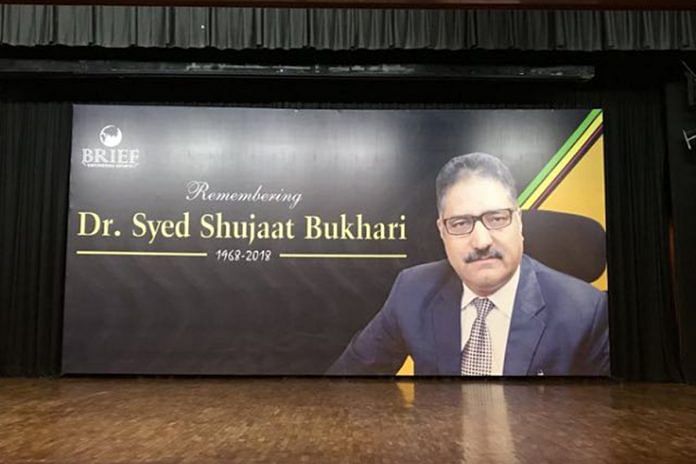Naveed Jatt killed in an encounter at central Kashmir’s Budgam district. He had escaped from police custody earlier this year.
New Delhi: Lashkar-e-Taiba (LeT) militant Naveed Jatt alias Abu Hanzullah, who is believed to be one of the main assassins of senior journalist Shujaat Bukhari, was killed in an encounter Wednesday.
Jatt was shot dead by security forces at central Kashmir’s Kuthpora in Budgam district. A senior Jammu and Kashmir police officer confirmed his death to ThePrint. Three army personnel were also injured in the encounter.
The encounter began in the early hours of Wednesday when a special operations group of the Jammu and Kashmir police cordoned off a house in Budgam following an intelligence input about the presence of militants, officials said.
The gun battle broke out when those holed up inside the house fired at security forces.
“It was swift operation carried out by security forces. We finally got the prize catch Naveed Jatt, who was a Pakistani national,” Director General of Police Dilbagh Singh said.
“We’ll be writing to the Ministry of Home Affairs to inform Pakistan to take the body,” he added.
A top LeT militant, Jatt was a close aide of the outfit’s commanders Abu Dujana and Abu Qasim — both killed in separate encounters by the Jammu and Kashmir police earlier.
The encounter began in the early hours of Wednesday when a special operations group of the Jammu and Kashmir police cordoned off a house at Kuthpora locality in Chadoora in Budgam following an intelligence input about the presence of militants, officials said.
The gun battle broke out when those holed up inside the house fired at security forces.
“It was swift operation carried out by security forces. We finally got the prize catch Naveed Jatt, who was a Pakistani national,” Director General of Police Dilbagh Singh said.
“We’ll be writing to the Ministry of Home Affairs to inform Pakistan to take the body,” he added.
The militant, hailing from Multan in Pakistan’s Punjab province, was among the most wanted in the Valley after escaping from custody in February this year.
He had first allegedly infiltrated from Pakistan in 2012 and was active in north Kashmir and subsequently south Kashmir.
Top police sources said Jatt operated in the hotbed of militancy, including Anantnag, Shopian and Pulwama.
In a 2014 firing incident in Shopian, five security forces personnel and two civilians were injured. He was also involved in attacks on the court complex in Pulwama twice. Naveed had also killed an assistant sub-inspector in Pulwama, said sources.
After his sudden escape in February, Jatt had been active in central Kashmir.
Bukhari’s murder
Jatt was allegedly among the three militants who fired a barrage of bullets at Bukhari, editor of Rising Kashmir, at Srinagar’s Lal Chowk area on 14 June.
He allegedly emerged on CCTV footage, along with two other militants, escaping from the site of Bukhari’s murder on a motorbike.
Bukhari’s killing was a huge setback for the troubled state. Five days after his death, the Bharatiya Janata Party (BJP) pulled the plug on its coalition with the Peoples Democratic Party (PDP), underlining Bukhari’s killing as one of the major reasons for its decision.
Also read: NHRC issues notice to J&K chief secretary, DGP over Shujaat Bukhari’s killing
The capture and escape
Jatt had been nabbed by the Jammu and Kashmir Police in 2014. At the time of his arrest, he was the LeT’s deputy chief.
“Naveed was arrested in south Kashmir’s Kulgam in June 2014. He was involved in the killings of policemen, and there were various cases against him,” former DGP Shesh Paul Vaid had told ThePrint.
His arrest was termed as a “major” breakthrough by security forces.
But the security establishment was dealt a huge blow on 6 February, when Jatt escaped from their clutches at the Shri Maharaja Hari Singh Hospital in Srinagar.
Militants opened fire inside the hospital premises, where Jatt had been brought along with six other prisoners for a check-up, killing head constable Mushtaq Ahmed and constable Babar.
Jatt fled in the melee.
His escape had raised questions about security lapses, particularly as to why prisoners were referred for treatment to a civil hospital with “thin” security.- With PTI inputs






